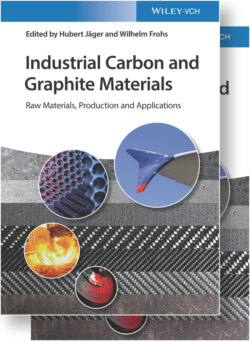Читать книгу Industrial Carbon and Graphite Materials - Группа авторов - Страница 299
6.1.3.1. Introduction
ОглавлениеPitch coke (hereinafter referred to as PC) is a blocky, granular, and powdery, black carbonaceous substance with maximum diameter of approximately 30 mm and with pores or cracks visible to naked eyes as manufactured by the carbonization at temperature equal to or higher than approximately 450 °C of coal‐tar pitch as a raw material withdrawn from the bottom of a distillation column in which coal tar described in Section 6.1.5.3.4 is distilled. PC contains nearly free of ash. This is a big difference from similar carbonaceous metallurgical coke for iron making manufactured by dry distillation of a coal.
Electrolytic smelting of aluminum and electrolysis of aqueous sodium chloride have been used in an industrial scale from the late nineteenth century to the early twentieth century, and the importance of the high purity of the carbon electrode is recognized. Consequently, manufacture of PC nearly free of ash using coal‐tar pitch as a raw material instead of metallurgical coke using a coal as a raw material has started. In the early stage retorts and pot still were used, but the Koppers process has been developed and established by the Koppers Company in Germany in the 1930s and is still used at present in Eastern Europe and China.
Nippon Steel Chemical Industry Co., Ltd. (at present, Nippon Steel & Sumikin Chemical Industry Co., Ltd.) has thereafter used in 1968 the licensing technology from the Lummus Co. in the United States to establish a production process by delayed coking [1], and this process is at present used to manufacture PC in Japan and China. Nippon Steel Chemical Co., Ltd. (at present, Nippon Steel & Sumikin Chemical Industry Co., Ltd.) [2, 3] and Mitsubishi Kasei Corporation (at present, Mitsubishi Chemical Industries Ltd.) [4] have independently succeeded in 1980 scaling up the purification of coal‐tar pitch and initiated industrial scale production of pitch needle coke by the delayed coking process.
An annual production volume of PC in 2009 is estimated to be approximately 900 000 t, and its production is increased particularly in China as the center where extensive economic development is under way. Major production sites for PC are located in China and in the Eastern European region including the former Soviet Union based on the Koppers process and in the East Asian region of China and Japan and the Southern African region based on the delayed coking process.
The majority of PC is processed for making a carbon or graphite electrode. PC is used as a raw material to produce a graphite block followed by machining to form various parts and jigs because it does not melt at high temperature, impurities are easily removed, and it has good lubricity and electrical conductivity.
